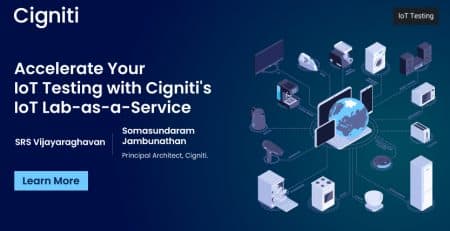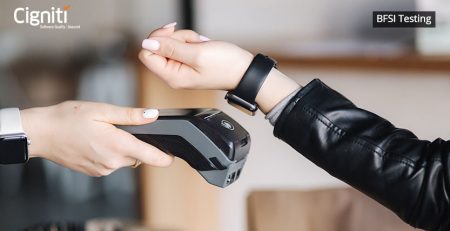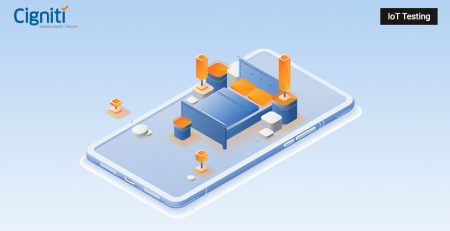IoT Testing is the Backbone of Your Smart Home Solutions
Advancements in the field of Artificial Intelligence, Robotics, and Internet of Things are driving us to a future dominated by such state-of-the-art technology. Analyzing the rate at which these next-generations technologies are taking over our daily lives, Gartner predicted that by 2020, about 20.4 Billion “Connected Things” will be in use.
One of the most popular and promising use cases of the proliferating IoT devices is smart homes. The smart home market is growing fast and is expected to touch the $151.4 billion mark by 2024 at a CAGR of 12.02%. About 50% of everyday essential household consumable products will be auto-replenished from the “connected home” through Internet of Things. From smart phones to smart assistants and now smart homes, there has been a constant technology-wise evolutionary process ongoing. Smart home automation systems comprise of solutions such as motion sensors, leak detectors, doorbells, thermostats, cameras, dimmers, smart outlets and plugs, smart switches, striving to make our lives sophisticated, but easier.
This rapid growth of the smart home market comes with its own set of challenges that needs to be dealt with strategically, otherwise this entire ‘smart’ ecosystem will collapse irrecoverably. In order to keep everything intact and robust, IoT implementation in smart homes is of paramount importance.
Understanding a Smart Home Automation System
Virtual digital assistants are now facilitating and automating routine tasks through their intelligence. A typical automation system in a smart home controls the lighting, ambience, entertainment systems and appliances. It also includes a home security system abreast with features such as access control and alarm systems, thereby enhancing overall home safety.
Smart devices present a lot of challenges in terms of data security, access management, hardware challenges, compliance requirements, and integration management. The quality and performance of these devices are key factors to consider in home automation systems. Thus, testing end-to-end functionality of multiple devices across different platforms is of utmost importance to ensure safety in smart homes.
For example, if any intrusion like a theft occurs in the house, the alarm system must be aware of the incident occurred and instantly respond to it. This response can be a mobile notification or an alert to the nearest police station. If there is a smoke in the room, the system should detect and send an alert to the fire department. To ensure such immediate and accurate responses, the overall system needs to communicate effectively with each other and all the IoT devices should be connected with the concerned authorities also. This is where, IoT testing comes into picture as the backbone of a smart home system.
The Complexities Involved in a Smart Home System
IoT-based smart homes leverage devices ranging from simple stand-alone sensors to highly-sophisticated appliances and devices equipped with self-learning and artificial intelligence (AI) capabilities. To ensure that these IoT-enabled smart home systems function as specified, enterprises need to validate not just the technology, but the entire process involved. This includes the trigger that activates the device, the associated applications, network, and environment.
Interconnectivity, interoperability, and surrounding environment are the three aspects that need to be safeguarded for the successful effectuation of a smart home system. Interoperability refers to the ability of different software to communicate in a given situation. Lack of interoperability would result in a failure, compromising the safety and security of the smart home system.
Secondly, a huge number of devices are connected in a smart home system and all these different devices need to communicate with one another effectively. So, numerous devices and all the applications involved must connect continuously in a controlled and systematic manner. This simultaneous connectivity must always be ensured for overall performance of the entire system.
The third factor, the environment, acts as a stimulus to trigger smart devices into action. A smooth and flawless functioning across all these parameters is mandatory in an interconnected smart home ecosystem.
A dedicated IoT strategy help manage this complex network sprawled across such a diverse technological landscape.
Testing multiple Layers in an IoT Smart Home Automation System
The IoT system can be described as a web of interconnected layers consisting of – device, data ingestion and transformation, data processing, and application. All these four layers need to work in sync to effectively convert data to information that will initiate subsequent action. The multiple layers in an IoT system create a unique and complex architecture, which mandates various testing types across the system. Protocol and device interoperability testing, security and privacy testing, network testing, performance and real-time testing, end-user usability testing are all very crucial to deal with the challenges associated while validating IoT systems in smart homes.
Data security, Energy Efficiency and User Experience
Smart homes exist to make our lives safer, cheaper and easier. It is estimated that by 2020, Home security systems will account for over $100 Billion in the security market. About 45% of Americans save on average $1,179.60 per year with smart devices. More than half of Americans claim that smart products save them 30 minutes every day. But this is only possible through proper functionality, connectivity, and efficiency of smart devices in an IoT network.
A lot of confidential and sensitive data is generated while all the IoT devices are interconnected with the applications in a smart home system. The entire system will fall into chaos if such vital information is disclosed. There is a critical requirement to protect data privacy and deliver network reliability in a virtually connected environment. Hence, various nodes in a system must be critically tested to ensure that no sensitive information gets leaked, and effective firewalls should be built based on the defined vulnerabilities. Any breach in the smart home system can be prevented by testing the security and reliability of the IoT network.
IT will play a crucial role in the future of energy landscape especially in the renewable energy sector. The scarcity of resources has put a pressure on the growing need for home automation. Smart home technology is more energy-efficient than any traditional home appliances and electronics. The connected appliances are designed to work in such a way that least amount of energy is consumed, thus, resulting in decreased energy consumption costs.
The Future of Testing in Smart Homes
Technology and business processes merge together in smart homes to drive a personalized customer experience. In this digital age, the notion of quality is linked to all these three things – customer experience, business process, and technology. Since, user experience and user satisfaction help in bringing profitability to the business, assuring quality in the home automation environment is a prime necessity.
Implementing IoT with intelligent devices is essential in smart homes to streamline various operations and facilitate an exchange of data. This also means that the applications managing these devices need to get tested for scalability, performance, functionality, and security. Along with IoT testing and Quality Assurance in smart homes, there is the need for test automation to speed up the process and improve test coverage. End-to-end automation and service virtualization can help achieve a faster release time by eliminating human intervention. Quality Engineering and Digital Assurance also play a very crucial role in the future of smart home system. Along with the advent of smart technologies in almost every sector, the face of the testing industry is also changing at a rapid pace, and the enterprises need to adopt new methods of software testing to cope up with this change.
Cigniti understands the testing needs of the smart home systems. The world around us is undergoing massive transformation with the help of futuristic technologies. Having delivered best-in-class testing services to organizations all over the globe, and with high-end capabilities in IoT testing and Digital Assurance, Cigniti’s services can strengthen the smart home ecosystems with precision and high standards of software testing services.





Leave a Reply